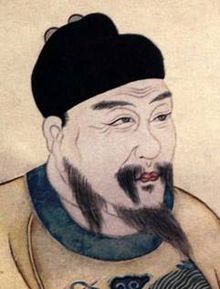- Zhu Yujian, Prince of Tang
-
Zhu Yujian, Prince of Tang 
Emperor of the Southern Ming Dynasty Reign August 1645 – October 1646 Predecessor Hongguang Emperor Successor Dynasty split, with both the Shaowu Emperor and the Yongli Emperor claiming the throne Chancellors Family name: Zhu (朱)
Given name: Yujian (聿鍵)Era name and dates Longwu (隆武): August 1645 – October 1646 Posthumous name 配天至道弘毅肅穆思文烈武敏仁廣孝襄皇帝 Temple name Ming Shaozong
明紹宗House Southern Ming Dynasty Father Zhu Qisheng Born 1602 Died October 1646 (aged 44) Zhu Yujian (朱聿鍵; pinyin: Zhū Yùjiàn; 1602–1646), the Prince of Tang, reigned as the Longwu Emperor of the Southern Ming dynasty from 18 August 1645, when he was enthroned in Fuzhou, to 6 October 1646, when he was captured and executed by a contingent of the Qing army.[1] He was a ninth generation descendant of Ming founder Zhu Yuanzhang.[2]
Contents
Early life
Before ascending to the throne he followed his father as the Prince of Tang, their fief being situated in Nanyang prefecture, in Henan province. In 1636 he was stripped of his title by the Chongzhen Emperor and put under house arrest in Fengyang. His former title was transferred to his younger brother Zhu Yumo (朱聿鏌). In 1641 the latter committed suicide when Li Zicheng invaded Nanyang. After the death of the Chongzhen Emperor 1644, his successor on the Ming throne, the Hongguang Emperor released the Prince of Tang from his arrest.
As emperor
When Qing forces captured Nanjing in June 1645 he fled to Hangzhou. In August of the same year at the behest of several high officials he ascended to the Ming throne in Fuzhou, taking the reign title Longwu (隆武; pinyin: Lóngwǔ). His era name means "Plentiful and martial". After a promising start, Fujian's geographical position on the margin of the empire, cut off the heartland through several mountain ranges, as well as his lack of effective troops and the failure on part of the officialdom to find a united stance doomed the Longwu government. When Qing forces invaded Fujian in the late summer of 1646, Zheng Zhilong, the emperor's strongest ally, surrendered while his son Zheng Chenggong (the famous Koxinga) retreated to sea.
The Prince of Tang was left with a dwindling court. On 6 October 1646, he was captured and immediately executed.
Personality
Against the Ming policy of keeping imperial princes out of politics, the Prince of Tang early on showed interest in the government of the empire and strove for a larger role of the princes in it. His initiatives had brought him under house arrest during the reign of the Chongzhen Emperor, but his knowledge of history and of Ming institutions, paired with a diligent personality, made him take his imperial role seriously.[3]
Zhu Yujian is said to have had a very close relationship with his wife, who had shared his hardship when he was incarcerated.[3] Contrary to Chinese custom, he steadfastly declined to take any concubines.
Notes
- ^ Struve 1988, pp. 665 (date of enthronement) and 676 (date of capture and execution).
- ^ Struve 1988, p. 665, note 24.
- ^ a b Struve 1988, p. 669.
Bibliography
- Struve, Lynn A. (1988). "The Southern Ming, 1644–1662". In Frederick W. Mote and Denis Twitchett. The Cambridge History of China, Volume 7, The Ming Dynasty, 1368–1644, Part I. Cambridge: Cambridge University Press.
Zhu Yujian, Prince of TangBorn: 1602 Died: 1646Regnal titles Preceded by
The Hongguang EmperorEmperor of the Ming Dynasty
1645–1646Succeeded by
Dynasty split, with both the Shaowu Emperor and the Yongli Emperor claiming the throneEmperor of China
1645–1646Monarchs of the Ming Dynasty  (List)
(List)Emperors Sovereigns 1 Also Vietnamese monarch.Categories:- 17th-century Chinese monarchs
- 17th-century executions
- Executed Chinese people
- Ming Dynasty emperors
- People executed by the Qing Dynasty
- Southern Ming Emperors
- 1602 births
- 1646 deaths
Wikimedia Foundation. 2010.
